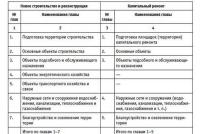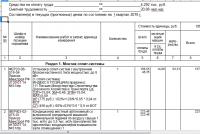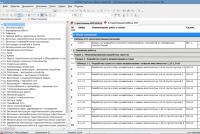Account statement 1s. Accounting info. Making a backup copy of the database
Bank statements are entered in the 1C 8.3 Accounting 3.0 program:
- Manual entry of bank statements;
Entering data on the receipt and withdrawal of funds in 1C 8.3 occurs in the Bank statements journal. The magazine is located in the Bank and Cashier section:
To manually enter an extract into the program, you must click on the book in the form of a journal. Admission or book. Write-off.
There is another way to enter bank statements manually: based on other documents. Then the data of receipts and write-offs are filled in automatically according to documents - grounds.
- : drawn up on the basis of an invoice to the buyer, a payment request, cash withdrawal, sales (act, invoice) and other documents.
- FROMdene scriptureimportant means: drawn up on the basis of documents Supplier invoice, Receipt (act, invoice), etc.
According to the received bank statements of cash flows, the accountant enters information into the 1C program:

Receipt to the current account in 1C 8.3
To enter data on the receipt of funds into the 1C 8.3 program, click book Admissionand choose the correct type of operation in the document. The set of available form details depends on this.
To make the buyer pay for the order against the future delivery of the goods, select the type of operation - Buyer Payment. We indicate the organization - Trading House "Complex". If there is only one organization in the database, then the organization field is not shown in the form. This field becomes visible only if there are several organizations in the database.
It is obligatory to fill in the field Bank account of the organization, Amount, Payer, Accounts for accounting of settlements and advances - 62.01 and 62.02:

Since the payment is made before the goods are sold to the buyer, the 1C 8.3 transactions will reflect the advance payment on the advance account 62.02:

Write-off from the current account in 1C 8.3
Write-off from the current account in 1C 8.3 Accounting 3.0 is made out according to the book. Write-off from the journal of Bank statements. The document form opens, in which the type of operation and organization are entered.
Select the type of operation Payment to the supplier. Fill in the data on the counterparty, amount, bank account of the organization.
We also fill in the tabular part of the document: agreement, VAT rate, purpose of payment:

In this case, the following postings are formed in 1C 8.3:

Uploading statements from Client Bank to 1C 8.3
The work of the accounting department is structured in such a way that during the day the accountant must prepare payment orders to the bank for current operations and post the received statements from the bank according to the operations already performed by the bank. Working in 1C 8.3 to interact with the bank is reduced to the execution in the program of payment orders outgoing to the bank and the subsequent entry of data on the operations performed by the bank.
Automation of this process involves loading bank statements from the Bank's Client into the 1C program and unloading payment orders from the 1C program to the Client Bank.
At the moment, most banks support the data exchange format with 1C programs. Loading bank statements after setting up an exchange with the bank is made from the Journal of Bank statements according to the book. Download... You can open the form for setting up an Exchange with a bank directly from the journal Bank statements - book. MORE - Exchange with the bank:

Setting up an exchange with a bank and downloading bank statements is discussed in detail in our other article: “.
According to the book. Download The data of the Bank's Client are read by the 1C program and loaded into the Bank statements journal:

When loading data, the 1C 8.3 program matches the database objects - the data from the download file. The message that the object "not found" is issued:
- By counterparty, if neither the bank account specified in the download file nor the TIN was found;
- For the account of the counterparty, if the account number is not found in the download file;
- Under the contract, if the owner of the contract and the desired type of contract are not found in the 1C database;
- If there are several identical objects in the database, the first one from the list will be selected and a warning will be issued on the situation;
- When re-loading documents, the program analyzes only the Amount and Type of payment data. If changed, the data is overwritten.
How to unload a payment order from 1C 8.3 to the Bank Client
Unloading payments from the 1C 8.3 program to the Client Bank can be done:
- From the processing form for the Exchange with the bank. If you put processing in "Favorites», It will be available from anywhere the user works;
- From the list of Payment orders for the book. Unload... When you click on the book. Unload the form of Exchange with the bank opens.
We discussed in detail the setting up of an exchange with a bank for unloading payment orders from 1C to the Client Bank in our other article: "".
According to the book. Unload from the Journal of Payment Orders, the data is uploaded to a text file and then transferred to the Client Bank:

Bank exchange form - Unload to bank tab:

You can study the features of processing banking operations in 1C 8.3: accounting accounts, documents, transactions, bank-client, you can correctly configure Direct Bank on our. For more information about the course, see our video:
On the site you can see our other free articles and materials on configurations:,
In the course of work, in each organization, there is interaction with other companies (organizations). For arrears of goods, works, services, taxes and other payments, you must pay. Currently, this process takes place through the Client-Bank system. This program is installed by bank employees on the computer of a company employee to make payments and download payment orders into the program in which accounting is carried out. Let's look at how the bank statements are loaded into 1C.
Uploading statements from the Client-Bank program
In order to download an extract from the Client-Bank program, you must:
- Generate an extract for the required period;
- Export it to a text file for data transfer.
Export occurs when you click on the button "Export", "Export" or something similar, in different programs of the Client-Bank this button is called differently. The generated file is unloaded for export to the desired folder, according to a predefined path.
In front of the tabular part of the document in the right corner we find the "More" button, click on it, a window appears with a list of functions, select the "Exchange with bank" item in it.

- The organization for which the payment orders will be loaded;
- Organization bank account.

Click at the bottom of the document "Download" and after that, in the tabular section, all statements from the bank will be loaded into the "1C: Accounting" program. After that, we look at the report on the uploaded file and proceed to the execution of payment orders.
You can set up automatic posting of payment documents on receipt and withdrawal. To do this, you need to complete the setup.
You can select the document "Settings with Client-Bank":
- By clicking the “Settings” button at the bottom of the “Exchange with bank” document;

- In the journal "Bank statements" select from the list the item "Set up an exchange with the bank" by clicking on the button "More".

In the settings, fill in the fields:
- We indicate the bank account on which the statements will be downloaded;
- The name of the program is selected from the list provided by the developers - this is the program you are working with. After that, the fields "Upload file from 1C Accounting" and "Upload file from 1C Accounting" open. "Upload file from 1C Accounting" only if outgoing payment orders are generated in the 1C database and then uploaded to the Client-Bank;
The condition that must be met is the name of the download file in 1C, it must correspond to the name of the upload file from the Client-Bank program.
- In the lower part of the setting, two fields open, in the left one indicates data on unloading, in the right part data on loading.
In the field “Automatically conduct after loading”, it is advisable to indicate two checkboxes on the positions “Receipt to current account” and “Write-off from current account”, while payment orders will be automatically carried out, which in the future must only be rechecked without going into each of them.

After downloading payment orders, you should carefully check the "Type of operation" and the created accounting entries, if errors are found, make corrections.
Unloading statements from the banking program in 1C is a very convenient procedure that greatly facilitates the work of the accounting service, significantly saving employees' time.
Today we will look at how to correctly conduct a bank statement in 1C.
Now we will take a closer look at the issue of working with such a document as 1C bank statement. As an example, let's take a situation when you need to make a non-cash payment according to a delivery contract.
For example, there is a certain Pilot TD company, which must pay the UkrPostachSbut company a certain amount. To reflect this action, you must open the item in the "Bank" menu. There, select the section "Outgoing payment order". The same procedure can be done by entering the control panel. There will be a bookmark of the same name, and click on it.
You need to add a new entry in the payment order journal. The payment order must be executed in accordance with the requirements (depending on the characteristics of the transfer), and then saved.


After that you need to open a special category called "Bank Statement". There, set the day on which the bank statement is saved directly.


Once you have set the date, you need to add another statement.

In the newly created statement, you must fill in the bank account, and also do not forget to put the date. A future bank statement in 1C will be generated on it.

If you have filled in all the required fields correctly, you will now have access to the functional panel. Find the "Pick up unpaid" tab on it.

A window will open in front of you, where you will need to mark the desired document with a tick (or several documents at once). When the checkboxes are ticked, click on the "Post Marked" button.

When the conduction is completed, you need to close the form. Now you can see an extract in 1C, which was generated by the required date.

There is another simple way to generate outgoing and incoming bank documents. They are formed directly from the statement form itself. It's easy to do, just click on the "+ Add" button. And then in the same window you can use 1C documents and:
- change the status of payment of documents and much more.
navigate through all statements;
view the results of the event;

In this material, we will talk about how to use the functionality of bank statements in a software product called "1C 8.3 Accounting 3.0" and conduct an exchange with a client bank:
Where the interface of the software product contains bank documentation;
How to generate a new payment order;
How to upload payment orders for payment to a client-bank;
How to download payment confirmation and incoming payment orders from a client bank.
Working with a banking institution
The general scheme of work with extracts "1C" for a given day is as follows:
We carry out downloads from the client-bank in the 1C software product: receipts for the previous day and confirmation of yesterday's outgoing payments, as well as commissions.
We form payment orders that must be paid today;
We upload them to the client-bank.
And according to this principle, every day, or any other period.
In the interface, the bank statements journal is located in the section entitled "Bank and Cashier":
How to generate an initial payment order
A payment order is a document created for the purpose of sending it to a banking institution. It is possible to print this order in a standard bank form.
Introduced on the basis of "Accounts", "Receipt of goods and services" and various other types of documentation. We emphasize that the document does not generate any accounting entries. And the following document "Write-off from the current account", which is in this chain, creates transactions.
In order to generate a new document, you need to enter the journal under the name "Payment orders" (the above section), and then press the button with the name "Create". As a result of the operations performed, a new document form will open.
You need to start by choosing the type of operation. The choice of future analytics depends on this:
For example, select "Pay to supplier". There are obligatory payments for this type of payment. Among these are the following:
Organization and its account - the details of our company;
Recipient, agreement and invoice - details of the required recipient counterparty;
VAT rate, amount and purpose of payment;
Having filled in all the fields, be sure to check the correctness of all the details.
How to unload payment orders from 1C to a client-bank?
The next stage is the transfer of information on new payments to the banking institution. As a rule, in enterprises it has the following form: for the whole day, accountants generate a large amount of documentation and at a specific time the responsible person unloads payment documents into a banking software product. The upload is carried out using a special file - 1c_to_kl.txt.
In order to unload, go to the journal of payment orders and click under the name "Unload". A special processing will open, where you must specify the organization and its account. After that, specify the dates for which you want to upload and where to save the resulting file 1c_to_kl.txt:
It must be uploaded to the client-bank.
Almost all bank clients support uploading a file such as "KL_TO_1C.txt". It contains all the necessary data on weekend and incoming payments for the required period. In order to download it, go to the journal called "Bank statements", and then press the button named "Download".
In the finish that opens, select the organization, its account and the location of the file itself (which you previously downloaded from the client-bank). Click on the "Update statements" button:
Then for the formation you will see a list of documents: both weekend and input (in particular, services of a banking institution). After checking, you will need to click on the "Load" button - the system will automatically create the necessary documents according to the list with the necessary accounting records.
If it happened that the system did not find the software and the counterparty in the 1C database, then it will create a new one. It is even possible that the counterparty exists in the database, but with different details.
In case you use the articles of the movement of funds, then by all means fill them in the list.
If there are no accounting accounts in the existing documents, then fill them in the information register under the name "Accounts of Settlements with Counterparties". They can be specified both for a contract or a counterparty, and for all documentation.
Usually, work with bank statements is configured automatically through the client-bank system, but the possibility of integrating client-bank and 1C is not always available. In this case, work with the bank will have to be done manually. Let's consider how the necessary documents are formed.
Creation of a payment order
To transfer money from the settlement account of the organization to pay suppliers, pay taxes and other contributions, you need to create a payment order. On the "Bank and Cashier" tab, select the "Payment orders" item:
A list of payment orders opens. In the upper left part of the document, click the "Create" button, a form for a new payment order opens. The fields are filled in it:
- Operation type - selected from the offered drop-down list according to the type of payment being made;
- Recipient - the required counterparty is selected from the directory of counterparties, the recipient's account and the contract are filled out automatically from the counterparty's details;
- Amount of payment;
- VAT - set by default from the counterparty data;
- VAT amount - calculated automatically;
- Purpose of payment.
It is important to correctly indicate the type of operation, since depending on the selected operation, the details of the document will change.
For example, when choosing the type of operation "Tax payment", you will need to fill in the "Type of obligation" field, it will be possible to change the KBK and the OKTMO code (by default, filled with actual data). The order for payment to the supplier looks like this:
After the completed payment order to the supplier is completed, no postings are generated in 1C, this is just an information document that fixes the need to generate a similar payment order in the client-bank system (recall, this is a manual job).
Another way to generate a payment order manually is through the "Pay" button, which, like the "Create" button, is located above the list of payment orders. When you click, a list opens from which you can select the desired type of payment: "Accrued taxes and contributions" or "Goods and services":
When choosing one of the items, it will analyze the organization's debt itself and generate a list of documents for which payment is required:
To create payment orders for several creditors at once, you can mark the necessary documents in the list and click the "Create payment orders" button.
New payment orders will be reflected in the list. They are in bold and not posted as they need to be verified. After checking the correctness of filling and the correctness of the amounts, the order is submitted. In this case, you also need to duplicate the order in the client-bank system.
As soon as the bank confirmed that this payment was transferred to the recipient, the movement of funds on the accounts must be reflected in 1C and debited from the organization's current account.
You can write off from the current account from the same payment order. In it, you need to set the status "Paid" and click on the hyperlink "Enter the debit document from the current account".
The document "Write-off from the current account", in contrast to the payment order, generates transactions in 1C.
You can see the transactions by clicking the "Show transactions" button:
Everything was filled in correctly: the funds were transferred from the organization's current account to the supplier's current account, which is reflected by the entry Dt60.01 - Kt51. In the list of payment orders, opposite the paid documents, a check mark appears in the first column:
Receiving payments from buyers
To reflect the receipt of funds to the settlement account of the organization, use the item "Bank statements" in the section "Bank and cash desk":
When you select this item, a journal opens, which reflects all receipts and debits from the current account:
To enter information about the receipt, use the button "Receipt". The document "Receipts to the current account" opens, in which the following fields are filled in:
-
The VAT rate, the agreement and the item of movement of the DS are filled in from the previously established values.
Operation type - in our case, "Payment from the buyer" is set;
Payer - the counterparty from which the money came is selected from the directory;
After filling in all the data, the document is carried out:
After conducting, you can check the postings:
Posting Dt51 - Kt62.02 shows that money has been received from the buyer to our account.
The list of bank statements shows current information on the current account status:
Provides information on the amount at the beginning of the day, receipts and debits for the day, the balance at the end of the day.
If you need to clarify information for any other day, you can use the calendar to select the desired date:
A list for the selected day will be formed, which will also show all information about the account status.
Register of documents
To obtain summary information on transactions on a bank account, use the report "Register of documents", the button of the same name for its creation is in the journal of bank statements. After pressing the button, a document for printing is formed:
An already completed document is created, it remains only to post it after verification:
The counterparty's debt for this sale is extinguished, the receipt automatically falls into the subordination structure of the sale:
Similarly, payment orders are issued on the basis of purchases and receipts of services.
Checking the current account status
You can check the status of the current account both in the journal of bank statements, and through the "Start page" on the main page of 1C:
Also, to check the account, you can use the balance sheet of the account (51 accounts - for ruble transactions, 52 - for currency transactions).






